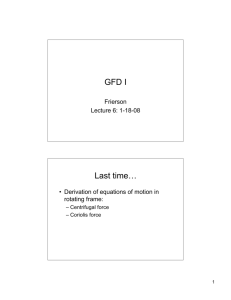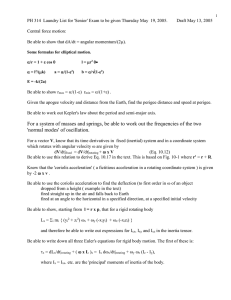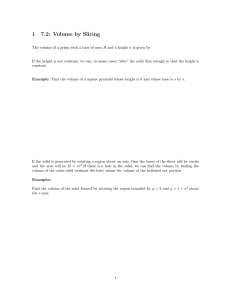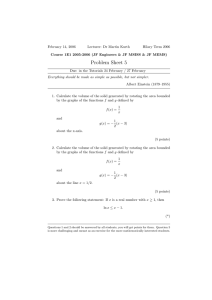Lecture L8 - Relative Motion using Rotating Axes
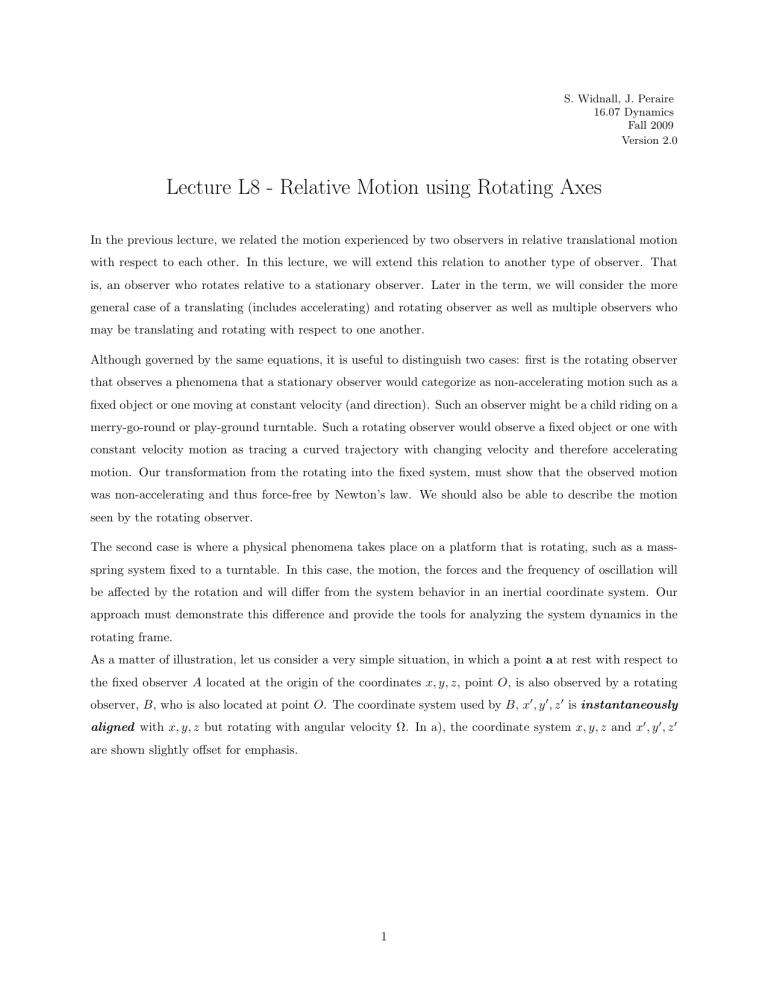
S.
Widnall, J.
Peraire
16.07
Dynamics
Fall 2009
Version 2.0
Lecture L8 - Relative Motion using Rotating Axes
In the previous lecture, we related the motion experienced by two observers in relative translational motion with respect to each other.
In this lecture, we will extend this relation to another type of observer.
That is, an observer who rotates relative to a stationary observer.
Later in the term, we will consider the more general case of a translating (includes accelerating) and rotating observer as well as multiple observers who may be translating and rotating with respect to one another.
Although governed by the same equations, it is useful to distinguish two cases: first is the rotating observer that observes a phenomena that a stationary observer would categorize as non-accelerating motion such as a fixed object or one moving at constant velocity (and direction).
Such an observer might be a child riding on a merry-go-round or play-ground turntable.
Such a rotating observer would observe a fixed object or one with constant velocity motion as tracing a curved trajectory with changing velocity and therefore accelerating motion.
Our transformation from the rotating into the fixed system, must show that the observed motion was non-accelerating and thus force-free by Newton’s law.
We should also be able to describe the motion seen by the rotating observer.
The second case is where a physical phenomena takes place on a platform that is rotating, such as a massspring system fixed to a turntable.
In this case, the motion, the forces and the frequency of oscillation will be affected by the rotation and will differ from the system behavior in an inertial coordinate system.
Our approach must demonstrate this difference and provide the tools for analyzing the system dynamics in the rotating frame.
As a matter of illustration, let us consider a very simple situation, in which a point a at rest with respect to the fixed observer A located at the origin of the coordinates x, y, z , point O , is also observed by a rotating observer, B , who is also located at point O .
The coordinate system used by B , x
�
, y
�
, z
� is instantaneously aligned with x, y, z but rotating with angular velocity Ω.
In a), the coordinate system x, y, z and x
�
, y
�
, z
� are shown slightly offset for emphasis.
1
Consider first case shown in a) , in which the point a located at position r does not move in inertial space.
Observer A will observe v a
= 0 for the point r .
Now consider the same situation observed by B .
In the rotating coordinate system, B will observe that the point r , which is fixed in inertial space appears to move backwards due to the rotation of B
� s coordinate system.
v a/B
= − Ω × r .
(1)
To reconcile these two observations, it is clear that to obtain the velocity in inertial coordinates, A must correct for the ”artificial” velocity seen by B due to the rotation of B � s coordinate system by adding Ω × r to the velocity reported by B .
v a/A
= v a/B
+ Ω × r (2)
In this case, we obtain the rather trivial result that v a
= 0 = − Ω × r + Ω × r .
(3)
If as is shown in b)the point a is moving with velocity v a/A
= r
A then we have the more general result v a/A
= v a/B
+ Ω × r (4)
Another way to obtain this expression is directly from Coriolis theorem relating the derivative of a vector seen by an observer in a rotating coordinate system to that seen in inertial space.
r
A
= r
B
+ Ω × r
In order to apply this relationship, it is not necessary that the vector Ω be constant in time.
Ω may be changing in magnitude or direction.
We have now completed the analysis of the position vector and the velocity vector in a co-located inertial and rotating coordinate system.
To determine the acceleration, we again discuss the general formula for the time derivative of a vector in a rotating frame, Coriolis Theorem.
2
Time derivative of a fixed vector in a rotating frame
We consider the reference frame of x
� y
� z
� rotating with an angular velocity Ω with respect to a fixed frame xyz with which it is instantaneously aligned.
We consider the more general case where Ω is not aligned with the z’ axis.
Let V be any vector, which is constant relative to the frame x
� y
� z
�
.
That is, the vector components in the x
� y
� z
� frame do not change, and, as a consequence, V rotates as if it were rigidly attached to the frame.
In the absolute frame, the time derivative will be equal to d V dt
= lim
Δ t → 0
( V + Δ V ) − V
Δ t
= Ω × V , which can be interpreted as the velocity of the tip of vector V .
The above expression applies to any vector which is rigidly attached to the frame x
� y
� z
�
.
Time derivative of a vector in a rotating frame: Coriolis’ theorem
Now let V be an arbitrary vector (e.g.
position, velocity), which is allowed to change in both the fixed xyz frame and the rotating x � y � z � frame.
If we now consider the time derivative of V , as seen by the fixed frame, we have xyz
= d V dt
= ( V x
� y
� z
�
+ Ω × V .
(5)
Here, ( V x � y � z � is the time derivative of the vector V as seen by the rotating frame .
The expression (5) above is known as Coriolis’ theorem .
Given an arbitrary vector, it relates the derivative of that vector as seen by a fixed frame with the derivative of the same vector as seen by a rotating frame.
Symbolically, we can write,
( ˙ ) xyz
= ( ˙ ) x � y � z �
+ Ω × ( ) .
We will often omit the notation ( ) xyz when the derivative is taken with respect to the fixed frame.
3
Summary: Relationships between position, velocity and accelera tion vectors from rotating to non-rotating coordinate systems
We will now systematically apply Coriolis theorem to determine the relationship between the position, velocity and acceleration vectors as seen by observer A and B .
Position vector
Since we have defined our coordinate system as having a common origin O and being instantaneously aligned , the position vector r seen by both the fixed observer A and the rotating observer B at this instant are the same.
r a/A
= r a/B
(6)
Note that this is an instantaneous concept, and therefore it is immaterial whether the observer B is rotating or not.
In other words, the above expression is valid at any given instant.
Of course, if we choose to express r a/A in xyz components, and r a/B in x
� y
� z
� components, then we will have to make sure that the proper coordinate transformation is done before the components of the vectors are added.
Also, since the orientation of x
� y
� z
� changes in time, this transformation will depend on the instant considered.
Velocity vector
Differentiating (6) with respect to time, we have, v a/A
= r a
= ( r a/B
) x
� y
� z
�
+ Ω × r a/B
= ( v a/B
) x � y � z �
+ Ω × r a/B
.
(7)
Here, we have used Coriolis’ theorem (5) to calculate the derivative of r a/B
, i.e.
r a/B
= ( r a/B
) x
� y
� z
�
+ Ω × r a/B
.
In the above expression, v a/A is the velocity of a relative to the fixed frame.
The term ( v a/B
) x
� y
� z
� is the velocity of a measured by the rotating observer, B .
Finally, Ω is the angular velocity of the rotating frame, and r a/B is the relative position vector of a with respect to B .
Acceleration vector
Differentiating (7) once again, and making use of Coriolis’ theorem, e.g.
d ( v a/A
) /dt = ( v a/B
) + Ω × ( v a/B
) or
(8) d ( v a/A
) /dt = d (( d r a/B
/dt + Ω × r a/B
) /dt + Ω × ( d ( r a/B
) /dt + Ω × r a/B
) (9)
4
we obtain the following expression for the acceleration, a a/A
= v a/A
= ( v a/B
) + Ω × ( v a/B
)
+ Ω × r a/B
+ Ω × ( v a/B
) + Ω × ( Ω × r a/B
)
= ( a a/B
) + 2 Ω × ( v a/B
) +
˙
× r a/B
+ Ω × ( Ω × r a/B
) .
(10)
The term ( a a/B
) is the acceleration of A measured by an observer B that rotates with the axes x
� y
� z
� instantaneously aligned with x, y, z .
The term 2 Ω × ( v a/B
) is called Coriolis’ acceleration.
The term
× r a/B is due to the change in Ω , and, finally, the term Ω × ( Ω × r a/B
) is called centripetal acceleration.
It can be easily seen that this acceleration always points towards the axis of rotation, and is orthogonal to Ω
(when trying to show this, you may find the vector identity, A × ( B × C ) = ( A C ) B − ( · ) C , introduced in Lecture 2, applied to Ω × ( Ω × r a/B
) = ( Ω · r a/B
) Ω − ( · ) r a/B
, useful).
Note Ω
A vs.
( Ω
B
When writing the derivative of the angular acceleration vector, Ω we did not specify whether the derivative was taken with respect to the fixed observer, A , or with respect to the rotating observer, B .
This may seem a little bit sloppy at first, but, in fact, it turns out that it does not really matter.
The time derivatives of vectors which are parallel to Ω are the same for both observers.
This can be easily seen if we go back to
Coriolis’ theorem (5) and apply it to Ω .
That is,
Ω
A
= ( Ω
B
+ Ω × Ω = ( Ω .
since Ω × Ω = 0, (cross product).
Acceleration in Rotating Cartesian Coordinates
For later application to problems involving orbital motion (and other applications), we now derive the expression for acceleration in inertial space ”seen” by the rotating observer B in the cartesian coordinates shown in a).
It is this expression for acceleration which must be used in the application of Newton’s Law
F = m a in a rotating coordinate system.
5
Without loss of generality, we take Ω to be aligned with the z, z
� axis.
We have also allowed Ω to be a function of time although in most applications Ω will be constant.
The position vector is r = x
� i’ + y
� j’ + z
� k’ and Ω = Ω k .
The components of acceleration are a a a
�
� x y
� z
=
=
= d 2 x � dt 2 d 2 y
� dt 2 d 2 z �
− x
�
Ω
2
− y
� d Ω dt
− 2 Ω dy � dt
− y
�
Ω
2
+ x
� d Ω dt
+ 2 Ω dx dt
� dt 2
(11)
(12)
(13)
Note that since the Ω vector is aligned with the z axis, the rotation of the coordinate system does not add additional terms to the acceleration in the z direction.
The various terms in the x, y’ equations are the Coriolis and centripetal accelerations expressed in cartesian coordinates plus the effects of time-varying
Ω .
These are the expressions for acceleration that must be used in applying Newton’s Law to motion in a rotating cartesian coordinate system.
Of significant importance is the setting of boundary conditions.
We need 4 boundary conditions: the x’ y’ position of the particle; and the x’, y’ components of velocity as seen by the rotating observer .
Since the fixed and rotating coordinates are instantaneously aligned in our analysis, the position seen by both inertial and rotating observers is the same.
To determine the velocity boundary conditions, we distinguish between two cases: a) the observer and b) the actor.
a) the observer: If the phenomena takes place in inertial space,and the rotating observer simply observes
6
the motion, then the velocity of the particle in inertial space is v a/A
= v
0
, and the initial position is r = R
0
.
In this case, the boundary condition on velocity seen by the rotating observer is must be corrected to reflect the effect of his motion so that in the rotating coordinate system v a/B
= v
0
− Ω × R
0
.
b) the actor: If the rotating observer actually caused the motion he is observing, such as an astronaut tossing a cheeseburger to another astronaut, then the boundary condition to be applied to particle velocity is that observed (or caused) by the ”actor”, v a/B
= v
0
.
Note Example: Constant velocity motion observed by an observer rotating at constant Ω
We now consider a particle moving at constant velocity as shown in b) and consider what trajectory the rotating observer B would observe.
We take Ω to be constant in time as well.
For a particle moving with constant velocity, the motion observed by the rotating observer satisfies equation (9) and (10) with a x
= 0 and a y
= 0; for simplicity we will consider two-dimensional planar motion.
0 =
0 = d
2 x
� dt 2 d 2 y
�
− x
�
Ω
2
− 2 Ω dy
� dt dt 2
− y
�
Ω
2
+ 2 Ω dx
� dt
(14)
(15)
Of significant importance is the setting of boundary conditions.
We need 4 boundary conditions: the x y position of the particle; and the x, y components of velocity as seen by the rotating observer .
Since the fixed and rotating coordinates are instantaneously aligned in our analysis, the position seen by both inertial and rotating observers is the same.
These equations have a closed form solution.
We consider the simple case shown in b): a particle located at x
�
= R
0
, y
�
= 0 with velocity v x
= 0 and v y
= v
0
.
If v
0 is less than Ω R
0
, the particle observed by B would actually appear to move backwards along a trajectory as shown in b).
ADDITIONAL READING
J.L.
Meriam and L.G.
Kraige, Engineering Mechanics, DYNAMICS , 5th Edition
5/7, 7/6
7
MIT OpenCourseWare http://ocw.mit.edu
16.07 Dynamics
Fall 2009
For information about citing these materials or our Terms of Use, visit: http://ocw.mit.edu/terms .
